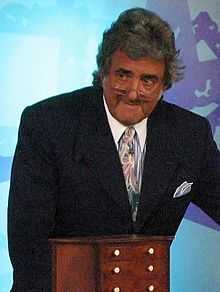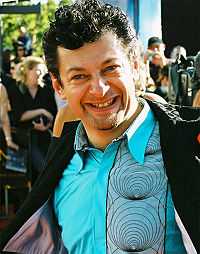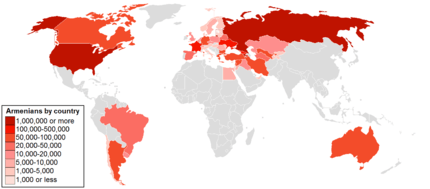Armenians in United Kingdom
| |||||
| Total population | |||||
|---|---|---|---|---|---|
|
Armenia-born residents 1,235 (2011 Census)[1] Armenian nationals 1,720 (2011 Census)[1] | |||||
| Regions with significant populations | |||||
| London, Manchester, Liverpool, Birmingham, Edinburgh | |||||
| Languages | |||||
| Armenian, English, Russian, Persian, Arabic, Turkish, French, Greek | |||||
| Religion | |||||
| Armenian Apostolic Church, Armenian Catholic Church, Armenian Evangelical Church | |||||
| Part of a series on |
| Armenians |
|---|
| Armenian culture |
|
Architecture · Art Cuisine · Dance · Dress Literature · Music · History |
| By country or region |
|
Armenia · Nagorno-Karabakh Republic Armenian diaspora |
| Subgroups |
| Hamshenis · Cherkesogai · Armeno-Tats · Lom people · Armeno-Greeks |
| Religion |
|
Armenian Apostolic · Armenian Catholic Evangelical · Brotherhood · |
| Languages and dialects |
| Armenian: Eastern · Western |
| Persecution |
|
Genocide · Hamidian massacres Adana massacre · Anti-Armenianism |
|
Armenia Portal |
The Armenian community of the United Kingdom consists mainly of British citizens who are fully or partially of Armenian descent. There has been sporadic emigration from Armenia to the UK since the 18th century, with the biggest influx coming after the Second World War. The majority are based in the major cities of London and Manchester. The 2001 UK Census recorded 589 Armenian-born people living in the UK,[2] although there are up to 18,000 ethnic Armenians including those who are British-born, and of part Armenian descent, living in the UK.[3]
History
The first Armenian community in Britain was formed in Manchester in the 19th century. A mixture of textile traders, small manufacturers and retailers, in 1870 they opened the first Armenian church in Britain (the Holy Trinity Church located in Manchester).[4]
Population distribution
According to Vered Amit's Armenians in London: The Management of Social Boundaries, published in 1989, around 10,000 Armenians were living in Greater London at the time. The majority were thought to be first-generation immigrants from Lebanon, Syria, Iraq, Iran and Cyprus.[5] They also include Armenians from Ethiopia, India, Egypt, Israel, as well as individuals from other countries.
Manchester has been home to an Armenian population since 1835, with 30 Armenian businesses thought to have been operating in the city by 1862.[6]
Media
The Tekeyan Cultural Union published "Erebuni" from 1979 to 1996. From 1979 to 1987, it was a bilingual Armenian/English monthly, turning into a biweekly from 1987 to 1996. For a brief period in 1993, it was published solely in English before reverting into a bilingual edition. It ceased publication in 1996.
Churches
There are three Armenian Apostolic Churches in Britain: Saint Sarkis in Kensington in London; Saint Yeghiche in South Kensington, also in London; and the Holy Trinity in Chorlton-on-Medlock, Manchester. The Armenian church of the Holy Trinity was the first purpose-built Armenian church in Western Europe and was opened at Easter 1870. The architects were Royle & Bennett, 1869–70.[7][8]
List of notable British Armenians
- Andy Serkis, actor, director, and author best known for playing Sméagol/Gollum, in The Lord of the Rings film trilogy
- David Dickinson, antiques expert and television presenter
- Levon Chilingirian OBE, musician
- Ara Darzi, Baron Darzi of Denham KBE, surgeon and first British-Armenian peer
- Calouste Gulbenkian, one of the founders of Royal Dutch Shell and oil magnate
- Kevork Malikyan, actor, various TV roles including Mind Your Language, and films including Indiana Jones and the Last Crusade, Flight of the Phoenix
- Roland Manookian, actor, major role in the Football Factory by Nick Love
- Kev Orkian, musician, comedian, actor
- Alexander Raphael, first person of Armenian descent to become a member of the House of Commons[9]
- Dikran Tahta, mathematician and teacher
- Robert Istepanian, professor of Data Communication at Kingston University[10]
- Alexander Seifalian, Professor, Head of nanotechnology and regenerative medicine at University College London
See also
- Ethnic groups in the United Kingdom
- List of Iranian Armenians
- List of Armenians
- Armenians in Russia
- Armenians in France
References
- ↑ 1.0 1.1 "Nationality and country of birth by age, sex and qualifications Jan - Dec 2013 (Excel sheet 60Kb)". www.ons.gov.uk. Office for National Statistics. Retrieved 11 June 2014.
- ↑ "Country-of-birth data, 2001". Organisation for Economic Co-operation and Development. Retrieved 2008-09-14.
- ↑ "Population". Armenian Diaspora Conference. Archived from the original on March 27, 2008. Retrieved 2008-09-14.
- ↑ Celebrating the first Christian nation
- ↑ Talai, Vered Amit (1989). Armenians in London: The Management of Social Boundaries. Manchester: Manchester University Press. p. 1. ISBN 0-7190-2927-9.
- ↑ "Multi-Cultural Manchester: Armenians". Manchester City Council. Retrieved 2009-08-22.
- ↑ The architects chose an eclectic neo-Gothic style. At the east end is a rounded apse and the interior is simple though the altar is elaborate.--Hartwell, Clare; Hyde, Matthew & Pevsner, Nikolaus (2004) Lancashire: Manchester and the South-East. New Haven: Yale University Press; pp. 421–22
- ↑ "The Holy Trinity Armenian Church of Manchester". Holy Trinity Armenian Church. 2009. Retrieved 14 December 2010.
- ↑ Seth, Mesrovb Jacob (1937). Armenians in India: From the Earliest Times to the Present. Calcutta: Asian Educational Services. p. 595. ISBN 978-81-206-0812-2.
- ↑ http://cism.kingston.ac.uk/people/details.php?AuthorID=317
Further reading
- Talai, Vered Amit (1986). "The circumscription of ethnicity: a case study of the London Armenian community". Ethnic and Racial Studies 9 (2): 211–18. doi:10.1080/01419870.1986.9993523.
- Talai, Vered Amit (1989). Armenians in London: the management of social boundaries. Manchester University Press. ISBN 978-0-7190-2927-1.
- Malik, Farah (1990). A Survey of the Armenian Community in London. London Research Centre. ISBN 978-1-85261-100-2.
External links
- Armenian Community and Church Council of Great Britain
- Centre for Armenian Information and Advice
- Homenetmen London Armenian Community
| ||||||||||||||||||||||||||||||||||||||||||||
| ||||||||||||||||||




